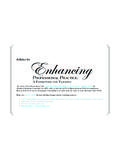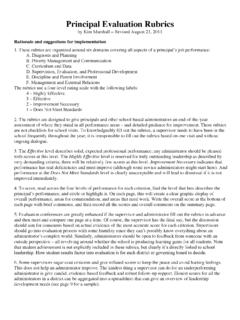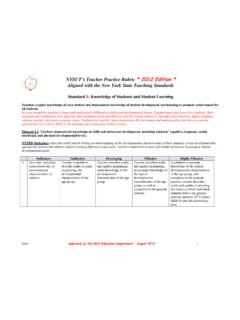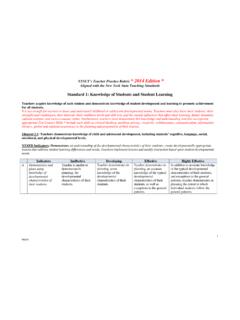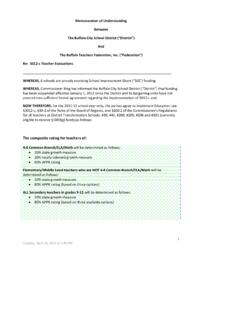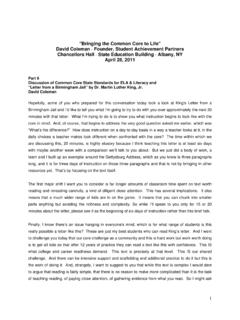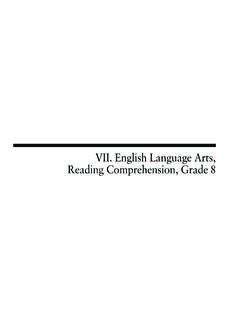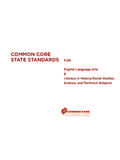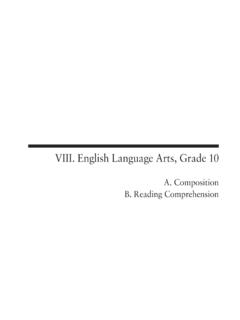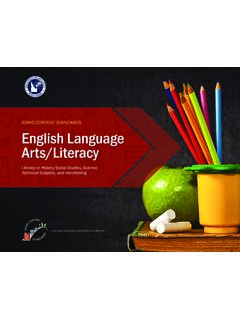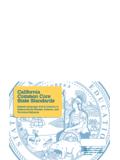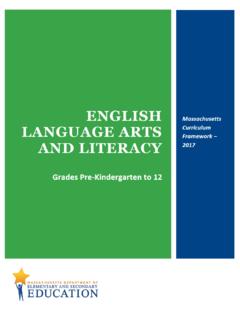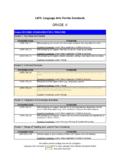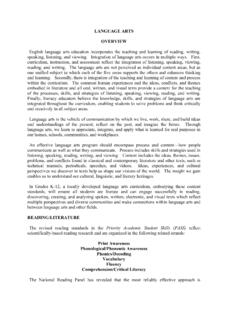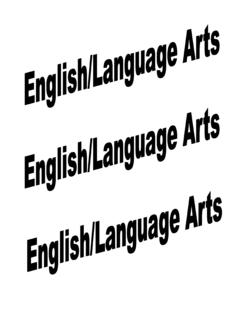Transcription of 3 8 Testing Program Questions and Answers
1 1 3 8 Testing Program Questions and Answers General Questions about the State Tests 1. Do the tests measure the Common Core Learning Standards? Yes. All Grade 3 8 Testing Questions measure the Common Core Learning Standards (CCLS). To guide test developers and help educators understand the Common Core, the New York State Education Department (NYSED) released all Grade 3 8 english language arts (ELA) and Mathematics test design specifications, passage selection criteria, and item review criteria. Each of these documents was developed with direct guidance from New York State educators, the authors of the Common Core, and other national Common Core experts. NYSED is confident that the Questions on the 2014 tests measure the Common Core according to published New York test design specifications and national consensus. New York measures the Common Core in ways comparable to the two national test consortia, Partnership for Assessment of Readiness of College and Careers (PARCC) and Smarter Balanced Assessment Consortia (SBAC) and consistent with the guidance from Achieve, Council of Chief State School Officers (CCSSO), Council of Great City Schools, National Association of State Boards of Education, National Governors Association, and other national organizations.
2 All of New York s 2014 Grades 3 8 ELA and Mathematics test Questions have been thoroughly evaluated by independent reviewers. These content and measurement experts, including New York State educators, nationally recognized content experts and professional evaluators (HumRRO) have consistently found that the items on the tests measure the Common Core with fidelity and are fair measures of student achievement. For more information about how Questions are designed and reviewed to ensure accurate and fair measurement of the Common Core, please see core assessment design 2. Do Common Core tests require excessive or rote standardized test preparation? No. NYSED discourages rote standardized test preparation, which takes time away from learning. The best preparation for Testing is good teaching. 3. Did NYSED take feedback from last year to change this year s tests? Yes. In response to last year s feedback, NYSED changed the ELA Day 2 book structure, reduced the number of Questions , and reduced test time.
3 NYSED provides opportunities for anyone to share feedback on state tests through our department email mailbox and phone lines ( ). 2 4. Why can t all the items be released? Why do New York State educators need to maintain test security? In 2013, 25% of the actual test Questions were released in the summer. This summer, we plan to release significantly more Questions from the 2014 tests. Questions remain secure for most Testing programs (SAT, AP, LSAT, MCAT, K12 state tests, certification tests, etc.). This is to ensure fairness. The test scores would not mean the same for all students if some students received narrow test prep on test Questions ahead of time and others did not receive such test prep. In addition, effective teachers focus not on individual Questions and the way a particular question happens to measure a standard, but rather on the learning standards that the Questions measure. Questions measure the standards in a variety of ways; a focus on specific Questions is an artificial and unnecessary narrowing of what we value in student learning, and prepares students to think about a standard in one small way.
4 It takes about two years to write, review many times, field test and review again a question before it is used on a test for scoring purposes. NYSED s request of the legislature for additional funds to increase the number of test forms and support the release of more test Questions was not funded in this year s budget. New York is unique among all states in that we print and distribute all of our own Testing forms. Due to our capacity constraints, we can only have four versions of a test. Most states our size have 25 40 versions. The more versions of a test, the more flexibility the state has in administering field test Questions and linking Questions , and releasing Questions after the test. 5. Since Questions must be kept confidential, how do educators and parents know what the test will be like? NYSED has been transparent about the Common Core assessments. Starting in June 2012, we posted sample Questions to show how the standards would be measured ( york state common core sample Questions ).
5 In Fall 2012, we provided grade specific test guides that articulated specifically how the shifts in instruction would be assessed ( guides for english language arts and mathematics). That same school year, we provided the exact criteria used to select passages for the test and writing Questions ( core assessment design). We have released 25% of the Questions used on the actual test. For every released question , we provided an explanation for how the question measures the intended standard, an explanation of why the right answer is right and why the wrong Answers are plausible (because they are based on common misconceptions) but incorrect, and for constructed response Questions , we release several examples of student work, with explanations of why the response got the score it did. 3 We have also provided detailed descriptions of the specific knowledge and skills measured at each of the four performance levels on the test ( level descriptions for ela and mathematics). Additionally, through their Regional Information Centers (RIC), schools have secure access to the data for every item that contributes to a student's score.
6 RICs provide reports that indicate the percent of students that scored each test question correct and, for the released items, the percent of students that selected each incorrect response. For each question , we also provide the standard it measures. This information allows educators to answer Questions such as, How did the students in my class and school perform on the Questions that measure each standard? How can I teach a standard differently next year if my student struggled? For the released test Questions , educators can identify the most common mistake their students made on each question , and determine what they can do next year to help students resolve that misconception. These resources are testament that the results of the state assessments provide a valid and rich source of information about student performance that complements what educators and parents know from classroom based work. 6. What information is provided to parents and families about student performance on the tests?
7 State assessment results are provided by NYSED and by the local district or BOCES. The state provides the Individual Score Report (ISR). The state provides extensive guidance for parents to help understand the ISR and how to use the report as a basis of discussion with the child s teachers. This guidance can be found at 3 8 ela mathematics tests results score reports. In addition to state level feedback, Regional Information Centers (RICs) have access to the data and resources necessary to generate more detailed parent feedback reports (for suggested data analyses, see data analyses for 3 8 ela and mathematics state tests) that best meet local needs and requests. 7. It doesn t seem like students have enough time to complete the test; will that affect test scores? We will continue to collect feedback on any difficulties students may have had completing specific sections of the tests. After we receive statewide results from regional scanning and scoring centers, we investigate whether the length of the Testing sessions affected student performance.
8 Based on the results of the analyses, we determine if changes to the number of items or the amount of time allowed are warranted for future tests. Following the 2013 Grade 3 8 test administration NYSED 4 conducted in depth analyses of student responses to determine what effect, if any, time had on performance. The results of those analyses indicated that time was not a factor in determining student performance. 8. How long are the grades 3 8 tests? In grades 3 4, the typical time for completion is about 50 minutes per day for 3 days each for ELA and math. In grades 5 8, the typical time for completion is 50 60 minutes per day for 3 days each for ELA and math. Additional time is provided in case some students need more time to complete their work. The overall length of the grades 3 8 state tests has been reduced for this year's administration and was also reduced in 2012 13 compared to 2011 12. Since New York State adopted the Common Core in 2010, we have not added any new tests and total Testing time accounts for less than one percent of class time each year.
9 Questions and Answers about english language arts (ELA) 9. Do the ELA tests accurately and adequately measure a student s reading comprehension? Yes. ELA tests measure the Common Core ELA Learning Standards. The Common Core Learning Standards define reading comprehension as the ability to read and make meaning of text. To make sense of any text, students must be able to understand the main ideas and detail within the text, understand how an author builds and shapes meaning through their craft and structure ( , how an author tells their story or conveys information through specific choices of words, characters, events, chronology, etc.), and ultimately be able to integrate what they learn from the text into a greater body of knowledge. One of the fundamental ideas in the Common Core Learning Standards is that students must be able to read and make sense of text before as they truly learn to love reading. 10. Do the ELA tests measure understanding of small details rather than overall comprehension?
10 No, the test measures students ability to both identify key details and comprehend overall meaning. When students struggle to understand and identify details within a text, they will have difficulty understanding a text as a whole. Small details in text change meaning, color emotion, reveal point of view, define characters, and ultimately reveal meaning. Each of the Reading standards require understanding details whether it is the explicit identification of character traits, context, or ideas (Standard R3), using context to define unknown words (Standard R4), or using details as evidence to justify any inference (all Standards). 5 Below are Questions taken directly from the 2013 ELA Common Core tests that illustrate how students are required to demonstrate both overall comprehension of a passage as well as the ability to identify key details: Grade 3, page 17 As she waits her turn, how does Taylor feel about jumping off the diving board? Use two details from the story to support your answer.


